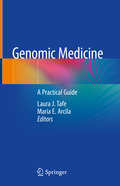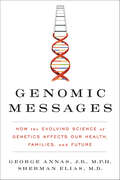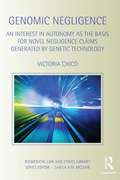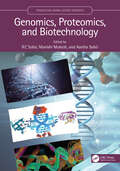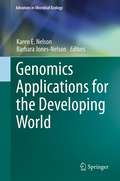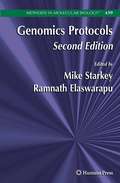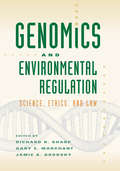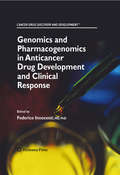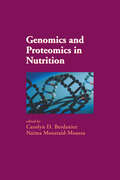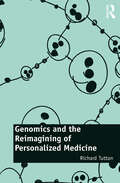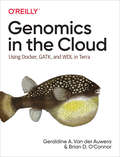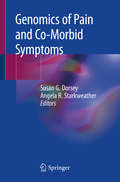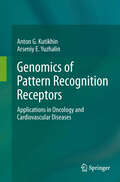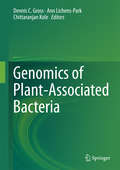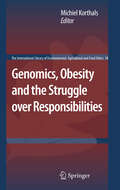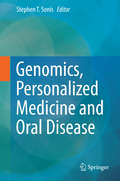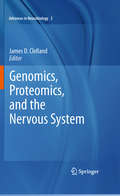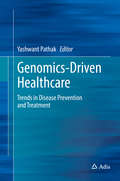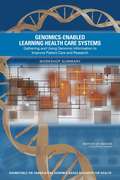- Table View
- List View
Genomic Instability and Cancer Metastasis
by Chris Maxwell Cal RoskelleyMetastasis is the primary cause of mortality associated with cancer, and tumor genomic heterogeneity is a likely source for the cells that support cancer progression, resistance to therapy, and disease relapse. This book connects cancer metastasis with genomic instability in a comprehensive manner. Section 1youtlines the fundamental mechanisms responsible for these cellular and tissue phenotypes. Section 2 discusses in silico, in vitro, and in vivo models used for the experimental study of these processes. Section 3 reviews emerging themes (ex. , microenvironment, mechanotransduction, and immunomodulation), and Section 4 highlights new therapeutic approaches to overcome the unique challenges presented by the heterogeneous and metastatic tumor. This book is intended for undergraduates and postgraduates with an interest in the areas of medicine, oncology, and cancer biology as well as for the content expert searching for thorough reviews of current knowledge in these areas. "
Genomic Medicine: A Practical Guide
by Laura J. Tafe Maria E. ArcilaThe field of Molecular Diagnostics is rapidly evolving and molecular characterization of neoplasms is becoming an increasingly important part of the pathologic work up and diagnosis of many tumor types. This work provides a high-yield reference book that compiles critical information related to molecular biomarkers for various solid tumor and hematologic malignancy subtypes. It is succinct yet comprehensive enough to be suitable for fellows in training and medical professionals with an interest in molecular pathology and biomarkers. The book covers many aspects of molecular diagnostics, from techniques to applications and comprehensive summaries of the current molecular biomarkers of critical importance in solid and liquid tumors. Attention is also specifi cally devoted to bioinformatics and next generation sequencing, as well as pre-analytical issues that must be considered for accurate interpretation of molecular results in the context of overall patient care.This text focuses on clinical utility and validity and serves as an “owner’s manual” in Genomic Diagnostics for the practicing pathologist, pathology fellows and residents and other health care providers. Physicians will find this book invaluable as a quick reference for current molecular testing modalities and guidelines, tumor board preparation, deciding which test to order and interpreting genomic laboratory results. In addition, it is an accessible for trainees as a board review preparation reference.
Genomic Messages: How the Evolving Science of Genetics Affects Our Health, Families, and Future
by Sherman Elias George AnnasTwo leaders in the field of genetics—a bioethicist-health lawyer and an obstetrician-gynecologist geneticist—answer the most pressing questions about the application of new genetics to our universal medicine and what personalized medicine means for individual healthcare.Breakthroughs in genetic research are changing modern medicine and pharmaceuticals. But what are these changes and how do they affect our individual care? Genomic Messages examines these groundbreaking changes and the questions they raise: What kind of specific medical innovation do we have to look forward to now and tomorrow? How will this “flood” of genetic messages change our lives, our interaction with our physicians and our healthcare system?Groundbreaking and provocative, Genomic Messages fuses the often conflicting worlds of medicine and law to provide information and insight that will impact the health choices of every one of us, from how medicine is practiced to concepts of privacy, confidentiality, and informed consent. Ultimately, it reveals how genetic information is changing how we think about ourselves, our health, and our future.
Genomic Negligence: An Interest in Autonomy as the Basis for Novel Negligence Claims Generated by Genetic Technology (Biomedical Law and Ethics Library)
by Victoria ChicoAdvances in genetic technology will lead to novel legal challenges. This book identifies four potential genomic claims which may be articulated as novel negligence challenges. Each of these claims is considered from the perspective of the English courts’ approach to novel kinds of damage. It is argued that these novel genomic claims are unlikely to be favourably received given the current judicial attitude to new forms of damage. However, Victoria Chico argues that the genomic claims could be conceived of as harm because they concern interferences with autonomy. Each claim is considered from the perspective of a hypothetical English negligence system imbued with explicit recognition of the interest in autonomy. Chico examines how recognition of this new form of damage would lead to novel genomic negligence claims being treated in a way which they would not, if considered within traditional parameters of harm in negligence.
Genomic Structural Variants
by Lars FeukThe completion of a consensus draft sequence for the human genome was the starting point for more thorough investigations of individual genome variation. The development of array-based strategies made it possible to look at our genome in new ways and for new types of variation to be discovered and characterized. Characterization of copy number variation and other forms of structural genetic variation has highlighted the complexity of human genetic variation and also provided significant insight into the evolution and dynamic nature of our genome. Genomic Structural Variants: Methods and Protocols provides an in-depth description of the developments in our understanding of structural genetic variation and its implications for human disease, from the introduction of microarrays up to current state-of-the-art sequencing strategies. It covers the major technologies used for research and diagnostics as well as web-based resources for variation data, and it then goes into depth regarding specific regions of the genome that differ in variation content. Specific patient groups where copy number variation has been shown to be of great importance are highlighted, and implications for both pre-natal and standard diagnostics are described. Written in the highly successful Methods in Molecular BiologyTM series format, chapters contain introductions to their respective topics, lists of the necessary materials and reagents, step-by-step, readily reproducible laboratory protocols, and notes on troubleshooting and avoiding known pitfalls. Authoritative and accessible, Genomic Structural Variants: Methods and Protocols provides complete comprehensive coverage of this burgeoning field.
Genomic Structural Variants in Nervous System Disorders (Neuromethods #182)
by Christos ProukakisThis volume covers the detection of structural variants (SVs), which require different strategies than the ones used for single nucleotide variants (SNVs). This book aims to provide readers with a combination of the latest “wet lab” methods and computational pipelines that target all SV classes. The chapters in this book cover topics such as detection of transposable elements (TEs) from short read data; long read sequencing used for multiple variable number tandem repeat analysis; genomic mosaicism in the nervous system; and optical genome mapping. In the Neuromethods series style, chapters include the kind of detail and key advice from the specialists needed to get successful results in your laboratory. Cutting-edge and comprehensive, Genomic Structural Variants in Nervous System Disorders is a valuable resource for scientists and researchers interested in learning more about this important field.
Genomic, Proteomics, and Biotechnology (Translating Animal Science Research)
by Manishi Mukesh Aastha Sobti Rc SobtiHigh-throughput molecular technologies ("omics") can help to decipher the contributions of different physiological systems and identify candidate molecules that are representative of different physiological pathways thereby allowing the discovery of biomarkers. Notably, the omics technologies along with and computational methods, bioprospecting, and artificial intelligence will continue to lead to better understanding of biological mechanisms that are responsible for physical attributes, or phenotypes. Research breakthroughs obtained through these technologies can be used to enhance productivity of food animals, meet the increasing demand for animal-sourced foods, enhance high-quality nutrient availability, ensure nutrient safety, mitigate the effects of climate variability, and result in new technologies that provide continued improvement in food security worldwide. Such breakthroughs are an urgent necessity because over the past 50 years, there has been an unprecedented increase in the world’s population, which will reach ten billion by the year 2050. Innovative and technological advancements that enhance all aspects of food production will arise from basic, fundamental research. Besides food, animal by-products have found many applications in the fields of pharmaceuticals, cosmetics, and household and industrial products. Hence, the need to ameliorate the productive, reproductive, growth performance, and disease resistance in animals has created a worldwide interest in gaining a deeper understanding of animal biology, biotechnology and genomics, and proteomics. The present volume thoroughly discusses the omics studies in domestic and non-domestic animals and their role in mitigation of various challenges ahead. The volume thus focusses on Omics (genomics, proteomics, transcriptomics, metabolonomics) technologies in identifying, characterizing biodiversity Role of molecular techniques for improvement of domestic and non-domestic organisms Animal and alternative model systems (using stem cells, tissue engineering, cell free systems, 3D platforms etc.) for studying life phenomena Genetically modified organisms as factories for the products
Genomics Applications for the Developing World
by Karen E. Nelson Barbara Jones-NelsonThis book evolved from the editors strong belief that the information and new developments that were evolving from the rapidly growing field of genomics and that are happening primarily in the developed world have not happened at a parallel rate in the developing world. One would have hoped that by now the technologies and approaches would have been adapted on a far greater scale. In addition to this, the associated information is not always easily accessible, and is not disseminated in a format that can become a useful reference for scientists, students and others who reside in developing countries.
Genomics Protocols
by Ramnath Elaswarapu Michael P. StarkeyExpert researchers from academia, industry, and leading genome centers provide a comprehensive generic set of protocols for gene hunting and genome analysis. Drawing on emerging technologies in the fields of bioinformatics and proteomics, these protocols cover not only those traditionally recognized as genomics, but also early therapeutic approaches exploiting the potential of gene therapy. Highlights include methods for the analysis of differential gene expression, SNP detection, comparative genomic hybridization, and the functional analysis of genes, as well as the use of bioinformatics for gene identification and the prediction of protein function.
Genomics Protocols
by Ramnath Elaswarapu Mike StarkeySince the first edition, published in 2001, genomics research has taken great strides. In this updated second edition, a team of expert researchers share the most current information in a field that has recently switched emphasis from gene identification to functional genomics and the characterization of genes and gene products. This volume approaches its subject with a broad perspective to supply its reader with a vital overview of genomics and its derivative fields.
Genomics and Bioinformatics
by Tore SamuelssonWith the arrival of genomics and genome sequencing projects, biology has been transformed into an incredibly data-rich science. The vast amount of information generated has made computational analysis critical and has increased demand for skilled bioinformaticians. Designed for biologists without previous programming experience, this textbook provides a hands-on introduction to Unix, Perl and other tools used in sequence bioinformatics. Relevant biological topics are used throughout the book and are combined with practical bioinformatics examples, leading students through the process from biological problem to computational solution. All of the Perl scripts, sequence and database files used in the book are available for download at the accompanying website, allowing the reader to easily follow each example using their own computer. Programming examples are kept at an introductory level, avoiding complex mathematics that students often find daunting. The book demonstrates that even simple programs can provide powerful solutions to many complex bioinformatics problems.
Genomics and Environmental Regulation: Science, Ethics, and Law
by Gary E. Marchant Richard R. Sharp Jamie A. GrodskyTo reduce the deleterious effects of environmental contamination, governments across the world have enacted regulations broadly conceived for entire populations. Information arising out of the Human Genome Project and other cutting-edge genetic research is shifting the policymaking process. This fascinating volume draws on experts from academia, government, industry, and nongovernmental organizations to examine the science of genomic research as applied to environmental policy. The first section explores environmental policy applications, including subpopulation genetic profiling, industrial regulations, and standardizing governmental evaluation of genomic data. The second section assesses from multiple angles the legal framework involved in applying genomics to environmental regulation. In the third section, the contributors review closely the implications of genomic research for occupational health, from disease prevention and genetic susceptibility to toxicants, to workers’ rights and potential employment discrimination. A fourth section explores the bioethical and philosophical complications of bringing genetic data and research into nonclinical regulatory frameworks.Genomics and Environmental Regulation points to ways in which information on toxicology and genetics can be used to craft more precise and efficient regulations.
Genomics and Pharmacogenomics in Anticancer Drug Development and Clinical Response
by Federico InnocentiThe availability of new molecular approaches to the selection of drug therapy is an emerging need, as the traditional approach based on the evaluation of patient and tumor characteristics is clearly far from optimal. Many, and in most cases the majority of treated patients do not have significant benefits from the treatment while they often experience moderate to severe toxicities. In "Pharmacogenomics, Anticancer Drug Discovery, and Response", edited by Federico Innocenti, readers will find a series of chapters addressing the role of genomic information in cancer therapy and in drug development representing a unique source, as it describes experimental approaches, statistical strategies, and clinical examples of the application of genomic medicine in oncology. This book provides the most comprehensive body of knowledge on the role of genetic and genomic variation in the individualization of drug therapies in cancer patients.
Genomics and Proteomics in Nutrition
by Carolyn D. Berdanier Naima Moustaid-MoussaWith contributions from 66 world-renowned authorities on the subject, Genomics And Proteomics In Nutrition focuses on the effect of genetic expression on protein production, establishing links between gene expression and nutrition, the influence of micro- and macronutrients on cellular homeostasis, and the relationship between diet, genetic
Genomics and the Reimagining of Personalized Medicine
by Richard TuttonDrawing on insights from work in medical history and sociology, this book analyzes changing meanings of personalized medicine over time, from the rise of biomedicine in the twentieth century, to the emergence of pharmacogenomics and personal genomics in the 1990s and 2000s. In the past when doctors championed personalization they did so to emphasize that patients had unique biographies and social experiences in the name of caring for their patients as individuals. However, since the middle of the twentieth century, geneticists have successfully promoted the belief that genes are implicated in why some people develop diseases and why some have adverse reactions to drugs when others do not. In doing so, they claim to offer a new way of personalizing the prediction, prevention and treatment of disease. As this book shows, the genomic reimagining of personalized medicine centres on new forms of capitalization and consumption of genetic information. While genomics promises the ultimate individualization of medicine, the author argues that personalized medicine exists in the imaginative gap between the problems and limits of current scientific practices and future prospects to individualize medical interventions. A rigorous, critical examination of the promises of genomics to transform the economics and delivery of medicine, Genomics and the Reimagining of Personalized Medicine examines the consequences of the shift towards personalization for the way we think about and act on health and disease in society. As such, it will be of interest to scholars and students of the sociology of medicine and health, science and technology studies, and health policy.
Genomics in the Cloud: Using Docker, GATK, and WDL in Terra
by Geraldine A. Van der Auwera Brian D. O'ConnorData in the genomics field is booming. In just a few years, organizations such as the National Institutes of Health (NIH) will host 50+ petabytesâ??or over 50 million gigabytesâ??of genomic data, and theyâ??re turning to cloud infrastructure to make that data available to the research community. How do you adapt analysis tools and protocols to access and analyze that volume of data in the cloud?With this practical book, researchers will learn how to work with genomics algorithms using open source tools including the Genome Analysis Toolkit (GATK), Docker, WDL, and Terra. Geraldine Van der Auwera, longtime custodian of the GATK user community, and Brian Oâ??Connor of the UC Santa Cruz Genomics Institute, guide you through the process. Youâ??ll learn by working with real data and genomics algorithms from the field.This book covers:Essential genomics and computing technology backgroundBasic cloud computing operationsGetting started with GATK, plus three major GATK Best Practices pipelinesAutomating analysis with scripted workflows using WDL and CromwellScaling up workflow execution in the cloud, including parallelization and cost optimizationInteractive analysis in the cloud using Jupyter notebooksSecure collaboration and computational reproducibility using Terra
Genomics of Pain and Co-Morbid Symptoms
by Susan G. Dorsey Angela R. StarkweatherThis book provides an overview of the field of pain genomics and the genomics of related, or co-occuring, symptoms, the current state-of-the-science, and challenges that remain. It brings differing views in the field together and provides examples of translational science from using cellular and rodent models to human clinical trials. This book's structure leads the reader through the physiology of pain and genomics into how pain is studied, mechanisms of acute and chronic pain, various protocols that are used throughout the field along with the pros/cons of the current methods used, and project into the future of pain genomics. This work is intended for classroom teaching, for nurses, for novice researchers in symptom science and pain research as well as students and postdoctoral fellows.
Genomics of Pattern Recognition Receptors: Applications in Oncology and Cardiovascular Diseases
by Anton G. Kutikhin Arseniy E. YuzhalinThis book offers comprehensive information on the polymorphisms of genes encoding pattern recognition receptors (PRRs). Following a short description of the general role of PRRs in the immune system, the structure and function of Toll-like and NOD-like receptors are examined in detail. The main focus is on the role of inherited variation in PRRs and their correlation to cancer and cardiovascular diseases. A review of all epidemiological investigations is included, and a concept of genomic risk markers for the prevention of various diseases is also discussed.
Genomics of Plant-Associated Bacteria
by Chittaranjan Kole Dennis C. Gross Ann Lichens-ParkThis book describes how genomics has revolutionized our scientific understanding of agriculturally important plant-associated bacteria. Each chapter focuses on the genomics of particular bacteria: the first described plant pathogen, Erwinia amylovora; phytoplasmas lacking cell walls; fastidious, phloem-restricted liberibacters; Pseudomonas syringae, which is a genetically tractable model system; Xanthomonas citri, which causes a disease that can devastate citrus crops and Pseudomonas fluorescens, which can protect plants from diseases. Topics considered in this volume include the importance of horizontal gene transfer in originating new bacterial strains and species and advances in transcriptomics that allow us to describe the complex regulatory networks critical to plant-microbe interactions. The availability of the Xanthomonas oryzae genome has led to new technologies in genome editing, which will revolutionize approaches to genetic engineering, even in eukaryotes. The contributions show how genomics has greatly accelerated progress toward understanding the biology of these bacteria and how that understanding can be translated into novel crop protection methods.
Genomics, Obesity and the Struggle over Responsibilities
by Michiel KorthalsThis volume addresses the overlapping aspects of the fields of genomics, obesity and (non-) medical ethics. It is unique in its examination of the implications of genomics for obesity from an ethical perspective. Genomics covers the sciences and technologies involved in the pathways that DNA takes until the organism is completely built and sustained: the range of genes (DNA), transcriptor factors, enhancers, promoters, RNA (copy of DNA), proteins, metabolism of cell, cellular interactions, organisms. Genomics offers a holistic approach, which, when applied to obesity, can have surprising and disturbing implications for the existing networks tackling this phenomenon. The ethical concerns and consideration presented are inspired by the interaction between the procedural perspective emphasizing the necessity of consultative and participatory organizational relationships in the new gray zones between medicine and food, and the substantive perspective that both cherishes individual autonomy and embeds it in socio-cultural contexts.
Genomics, Personalized Medicine and Oral Disease
by Dmd Stephen T. Sonis DmscThe objective of this book is to catalyze the application of genomics to the diagnosis and treatment of oral diseases by comprehensively presenting focused discussions on the current state of knowledge. The first section book provides basic information about genetics, genomics and personalized medicine and the informatical methods available to apply and organize genetic data so that it has clinical relevance. Recognizing the genetic robustness of the oral cavity, the introductory section includes chapters on the oral micro biome and host genomics and response to infectious agents. The next two sections contain chapters which describe the genomics of specific oral diseases and conditions, including the genetic basis for mechanism and risk of treatment toxicities associated with cancer therapy and bisphosphonates. Four chapters focus on gene-based therapies and the pharmacogenomics applied to oral disease. The final chapter presents a provocative summary which describes a comprehensive vision of the melding of genomics to personalized medicine and the potential actionable outcomes that will likely affect clinical practice in the upcoming years.
Genomics, Proteomics, and the Nervous System
by James D ClellandThis newest volume of Advances in Neurobiology discusses the utilization of genomic and proteomic technologies, to address facets of neurobiology including development and epigenetic regulation, functions in learning and memory, and changes associated with neurological and psychiatric disorders.
Genomics-Driven Healthcare: Trends in Disease Prevention and Treatment
by Yashwant PathakThis book evaluates trends arising in “-Omics” sciences in terms of their current and potential future application to therapeutic design and understanding of disease. Chapters consider the impact of pharmacogenomics and bioinformatics on drug development, as well as trends in genomics, as applied to understanding of neurodegenerative and lung disease, psychiatry and oncology.Following the genome studies released in early part of this century, the advent of the -Omics sciences (genomics and pharmacogenomics, proteomics, metabolomics, transcriptomics) has seen the expansion of a vast knowledgebase with utility in preventing and treating disease, and improving health for all. Bioinformatics and improved pharmacogenetic understanding forge a path for improved drug discovery and design methods accounting for differences in delivery and disposition across populations.
Genomics-Enabled Learning Health Care Systems: Workshop Summary
by Sarah H. BeachyThe inclusion of genomic data in a knowledge-generating health care system infrastructure is one promising way to harness the full potential of that information to provide better patient care. In such a system, clinical practice and research influence each other with the goal of improving the efficiency and effectiveness of disease prevention, diagnosis, and treatment. To examine pragmatic approaches to incorporating genomics in learning health care systems, the Institute of Medicine Roundtable on Translating Genomic-Based Research for Health hosted a workshop which convened a variety of stakeholder groups, including commercial developers, health information technology professionals, clinical providers, academic researchers, patient groups, and government and health system representatives, to present their perspectives and participate in discussions on maximizing the value that can be obtained from genomic information. The workshop examined how a variety of systems are capturing and making use of genomic data to generate knowledge for advancing health care in the 21st century. It also sought to evaluate the challenges, opportunities, and best practices for capturing or using genomic information in knowledge-generating health care systems. "Genomics-Enabled Learning Health Care Systems" summarizes the presentations and discussion of the workshop.
Genomics-Enabled Learning Health Care Systems: Workshop Summary
by Sarah H. BeachyThe inclusion of genomic data in a knowledge-generating health care system infrastructure is one promising way to harness the full potential of that information to provide better patient care. In such a system, clinical practice and research influence each other with the goal of improving the efficiency and effectiveness of disease prevention, diagnosis, and treatment. To examine pragmatic approaches to incorporating genomics in learning health care systems, the Institute of Medicine Roundtable on Translating Genomic-Based Research for Health hosted a workshop which convened a variety of stakeholder groups, including commercial developers, health information technology professionals, clinical providers, academic researchers, patient groups, and government and health system representatives, to present their perspectives and participate in discussions on maximizing the value that can be obtained from genomic information. The workshop examined how a variety of systems are capturing and making use of genomic data to generate knowledge for advancing health care in the 21st century. It also sought to evaluate the challenges, opportunities, and best practices for capturing or using genomic information in knowledge-generating health care systems. Genomics-Enabled Learning Health Care Systems summarizes the presentations and discussion of the workshop.

